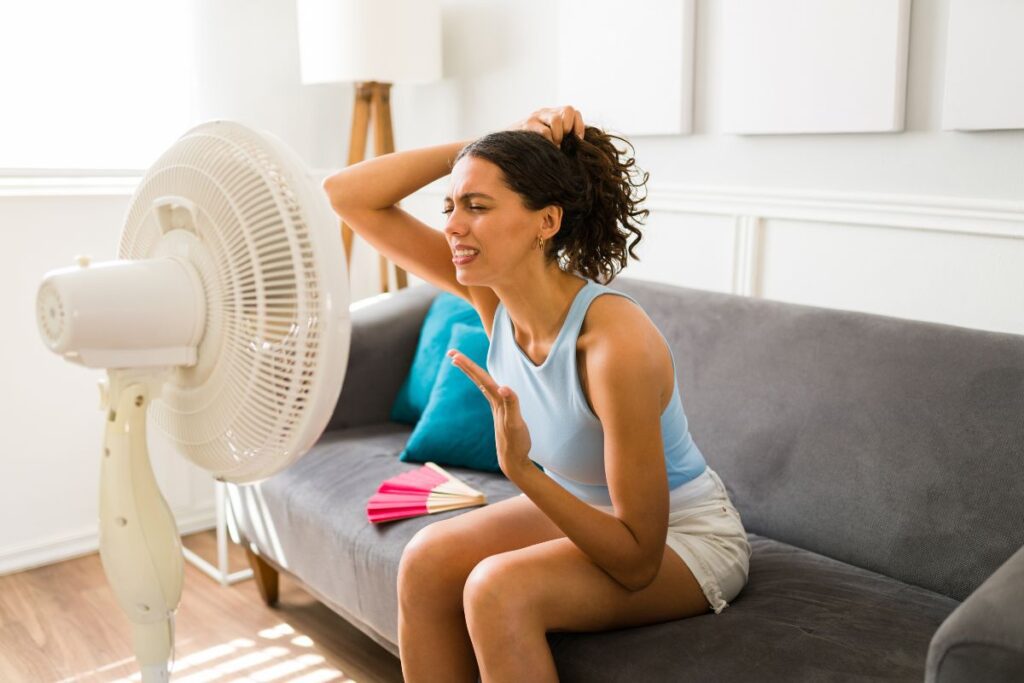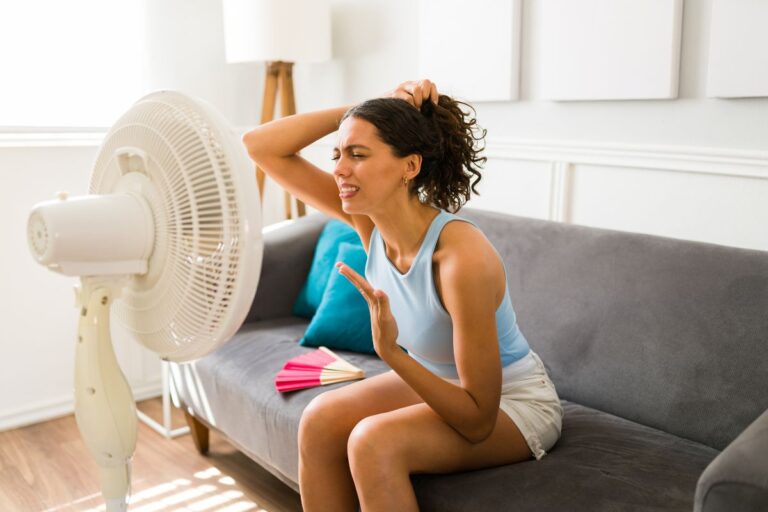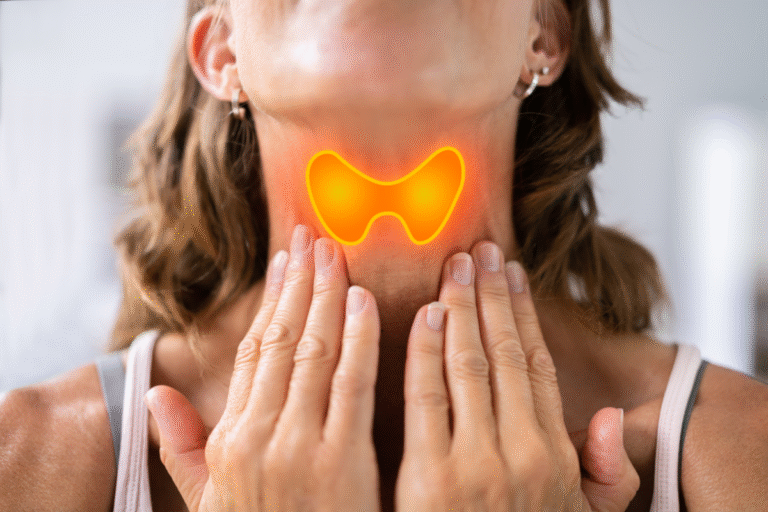
It’s a hot July afternoon in Highland, Washington. Maria, 52, is standing in the checkout line at the farmer’s market when she feels it—an internal wildfire rising in her chest. Within seconds, her face is flushed, sweat beads along her hairline, and her heart races. She fans herself, hoping no one notices, but the embarrassment stings almost as much as the discomfort.
She’s not alone. Hot flashes are one of the most common—and disruptive—symptoms of perimenopause and menopause. And for many women, the summer season takes that discomfort to the next level.
At Antigravity Wellness, we specialize in helping women understand and overcome the challenges of perimenopause and menopause through a comprehensive, personalized, and holistic approach. This blog dives into what hot flashes really are, why they get worse in the summer, and how you can find relief naturally—with or without hormone therapy.
🔥 What Are Hot Flashes?
Hot flashes are sudden, intense feelings of warmth, most often over the face, neck, and chest, sometimes accompanied by:
- Sweating (especially at night)
- Skin flushing
- Heart palpitations
- Chills following the episode
- Fatigue and sleep disruption
They’re caused by fluctuations—often drops—in estrogen that confuse the hypothalamus, the part of your brain that regulates temperature. Even small changes in body temperature can trigger your body to initiate a full “cooling” response: blood vessel dilation, sweating, and increased heart rate.
☀️ Why Hot Flashes Get Worse in the Summer
While hot flashes can strike any time of year, summer adds an extra layer of intensity for several reasons:
- Higher external temperatures challenge your body’s natural ability to regulate heat.
- Sun exposure can trigger internal temperature spikes that prompt more frequent or severe hot flashes.
- Dehydration is more likely in warm months and can worsen symptoms.
- Wearing the wrong clothing (synthetics or tight fabrics) prevents heat dissipation.
- Summer stressors (travel, disrupted sleep, social events) can further destabilize your nervous system.
Think of it this way: your body is already struggling to find its hormonal balance. Add 90-degree weather, a glass of wine, and a spicy taco, and you’ve got the perfect hot flash storm.
🌿 A Holistic Approach to Hot Flash Relief
Managing hot flashes effectively requires a multi-pronged, body-wide strategy. Here’s what we focus on at Antigravity Wellness:
1. Nutrition: Foods That Cool and Calm
Certain foods can help regulate temperature and hormonal shifts, while others can worsen symptoms.
Hot Flash-Soothing Foods:
- Soy products (tofu, tempeh, edamame) – rich in isoflavones, which mimic estrogen [Chen et al., 2015].
- Whole grains – stabilize blood sugar, reducing hormone fluctuations.
- Berries, leafy greens, and cruciferous vegetables – high in antioxidants.
- Omega-3s – found in flaxseeds, chia, and salmon, help reduce inflammation.
- Hydrating fruits like watermelon and cucumbers – naturally cooling.
Common Triggers to Avoid:
- Spicy foods
- Caffeine
- Alcohol
- Processed, sugary snacks
👉 Pro tip: Keep a food and symptom journal to see what triggers or soothes your body.
2. Lifestyle Hacks for Summer Survival
Managing your environment is just as important as managing your biology. Try these daily strategies:
- Layer your clothing with breathable cotton and linen fabrics.
- Stay hydrated (aim for at least 64 oz of water daily).
- Use cooling tools like fans, gel packs, and cooling towels.
- Exercise earlier in the day when it’s cooler and avoid overheating.
- Create a cool sleep environment: blackout curtains, a fan or AC, and moisture-wicking sheets.
- Practice nervous system regulation: breathwork, meditation, yoga, or journaling to reduce cortisol (a known hot flash trigger).
💊 Why BHRT Works So Well for Hot Flashes
One of the most effective tools in our toolbox is Bioidentical Hormone Replacement Therapy (BHRT). These are hormones (usually estrogen and progesterone) that are molecularly identical to the ones your body naturally makes.
How BHRT Helps:
- Replaces declining estrogen levels
- Restores normal function in the hypothalamus, reducing hot flash triggers
- Improves sleep, mood, and energy
- Reduces the severity and frequency of both day and night flashes
According to a 2017 clinical practice guideline by The North American Menopause Society, estrogen therapy remains the most effective treatment for vasomotor symptoms like hot flashes and night sweats. When prescribed and monitored appropriately, BHRT can dramatically improve quality of life.
We always ensure our clients are using FDA-approved formulations whenever possible and tailor dosing to their unique needs, preferences, and safety profile.
💊 What If You Can’t (or Don’t Want to) Use Hormones?
Hormone therapy—especially estrogen—is the gold standard for treating hot flashes. But not every woman is a candidate for BHRT. Whether due to personal choice, a history of hormone-sensitive cancer, clotting disorders, or other medical concerns, you may be looking for non-hormonal options that are still effective and FDA-approved.
Fortunately, there are several evidence-based alternatives that your doctor may offer for moderate to severe hot flashes:
- Fezolinetant (Veozah™) – FDA-Approved Non-Hormonal Option
Approved by the FDA in 2023, fezolinetant is a selective neurokinin-3 receptor antagonist (NK3RA). It works by directly targeting the brain’s thermoregulatory center, resetting your internal thermostat without the use of hormones.
- How it works: Estrogen decline increases neurokinin B activity, which disrupts temperature control. Fezolinetant blocks this signal to prevent hot flashes.
- Clinical results: In the SKYLIGHT 1 and 2 trials, fezolinetant significantly reduced the frequency and severity of hot flashes within 4 weeks.
🧪 Source:
- Yu J, et al. (2023). Efficacy and safety of fezolinetant for moderate to severe vasomotor symptoms associated with menopause: a randomized clinical trial. The Lancet.
https://doi.org/10.1016/S0140-6736(23)00451-4
- SSRIs and SNRIs – Antidepressants With a Dual Benefit
Certain antidepressants are shown to reduce hot flashes, especially for women who are unable to use hormone therapy. These include:
- Paroxetine (Brisdelle®) – the only SSRI specifically FDA-approved for hot flashes.
- Venlafaxine (Effexor XR®) – an SNRI commonly prescribed off-label for hot flashes.
- Desvenlafaxine (Pristiq®) – also shown to be effective in studies.
These medications are generally well-tolerated and can also help women dealing with mood changes, anxiety, or sleep disruption during perimenopause.
🧪 Source:
- Freeman EW, et al. (2011). Paroxetine for menopausal hot flashes: a randomized controlled trial. JAMA, 289(21), 2827–2834.
https://jamanetwork.com/journals/jama/fullarticle/196349
- Gabapentin (Neurontin®) – Originally for Seizures, Now for Sweats
Gabapentin, a drug typically used for nerve pain or seizures, has been shown to reduce hot flashes, particularly nighttime episodes.
- May cause drowsiness, which can be helpful for women struggling with sleep.
- Used off-label, often in low doses at night.
🧪 Source:
- Loprinzi CL, et al. (2002). Gabapentin, a non-hormonal treatment for hot flashes: a randomized controlled trial. The Lancet, 359(9323), 2052–2058.
https://doi.org/10.1016/S0140-6736(02)08992-6
- Clonidine (Catapres®) – A Blood Pressure Medication
Clonidine is an older medication that may reduce hot flashes by stabilizing blood vessels and lowering blood pressure, but it tends to have more side effects like dry mouth, fatigue, and dizziness, so it’s used less often today.
🧪 Source:
- Pandya KJ, et al. (2000). Oral clonidine in postmenopausal patients with breast cancer experiencing tamoxifen-induced hot flashes: a placebo-controlled randomized trial. Annals of Internal Medicine, 132(10), 788–793.
https://doi.org/10.7326/0003-4819-132-10-200005160-00006
⚖️ Choosing What’s Right for You
Non-hormonal options are not one-size-fits-all, and they don’t always eliminate symptoms completely—but for many women, they offer meaningful relief when hormones are not an option.
At Antigravity Wellness, we guide you through all your choices, using both functional and conventional medicine to help you make informed, empowered decisions about your body.
🧘♀️ Case Study: Maria’s Story
Maria came to us exhausted and exasperated. She had tried everything—supplements, avoiding triggers, meditation—but the hot flashes persisted, particularly in summer.
Together, we created a holistic, layered approach:
- Started low-dose estradiol patch with oral progesterone (because she has a uterus)
- Introduced a plant-based, high-fiber diet
- Focused on daily movement and mindful cooling routines
- Optimized her hydration and sleep environment
In just a few weeks, her daytime hot flashes had dropped significantly. Within two months, her night sweats were gone, and her confidence (and sleep!) returned.
🤝 You’re Not Alone—And You Don’t Have to Suffer
At Antigravity Wellness, we don’t believe in one-size-fits-all care. Whether you’re just starting to notice hormonal shifts or you’re knee-deep in the throes of menopause, we’re here to help you build a plan that works for your unique body.
✅ Personalized BHRT
✅ Functional nutrition guidance
✅ Mind-body stress support
✅ Safe, compassionate care
Book your brief initial consult call today and let’s get to the root of your hot flashes—so you can reclaim your summer, your sleep, and your sanity.
📚 Resources and References
- Chen MN, Lin CC, Liu CF. (2015). Efficacy of phytoestrogens for menopausal symptoms: a meta-analysis and systematic review. Climacteric, 18(2), 260–269.
https://pubmed.ncbi.nlm.nih.gov/22433977 - North American Menopause Society. (2017). The 2017 hormone therapy position statement. Menopause, 24(7), 728–753.
https://journals.lww.com/menopausejournal/Fulltext/2017/07000 - L’Hermite M. (2017). Bioidentical menopausal hormone therapy: registered hormones (nonoral estradiol±progesterone) are optimal. Climacteric, 20(5), 411–416.
https://doi.org/10.1080/13697137.2017.1376254 - Stuenkel CA, et al. (2015). Treatment of symptoms of the menopause: An Endocrine Society clinical practice guideline. J Clin Endocrinol Metab, 100(11), 3975–4011.
https://academic.oup.com/jcem/article/100/11/3975/2835992 - Imamura F, et al. (2020). Higher intakes of fruits and vegetables are related to fewer menopausal symptoms: a cross-sectional study. Maturitas, 134, 39–45.
- Shokrpour M, et al. (2023). Effect of omega-3 fatty acids supplementation on menopausal symptoms: a systematic review. Int J Reprod BioMed, 21(9), 755–768.
https://www.ncbi.nlm.nih.gov/pmc/articles/PMC10574492




